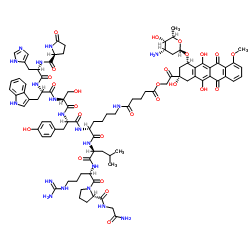| Description |
Zoptarelin doxorubicin (AEZS-108; AN-152) is a hybrid anticancer agent, containing Zoptarelin and Doxorubicin. Zoptarelin doxorubicin has been used to research targeting tumors expressing LHRH receptors. Zoptarelin doxorubicin abolishes tumor progression and induces remarkable apoptosis in vitro[1].
|
| Related Catalog |
|
| Target |
Apoptosis, LHRH receptors[1]
|
| In Vitro |
Zoptarelin doxorubicin (AN-152) inhibits almost 70 % of glioblastoma cell growth, increases almost 250% apoptosis and causes a greater increase in calcein retention[1]. Zoptarelin doxorubicin (AN-152) up-regulates the tumor suppressor and pro-apoptotic p53, and inhibits the expression of the primordial, neuroectodermal stem cell marker, nestin[1]. Cell Proliferation Assay[1] Cell Line: U-87 MG Concentration: 100 nM Incubation Time: 48 h Result: Brought about an almost 70 % inhibition of tumor cell growth. Apoptosis Analysis[1] Cell Line: U-87 MG Concentration: 100 nM Incubation Time: 48 h Result: Increased almost 250 % apoptosis. Western Blot Analysis[1] Cell Line: U-87 MG Concentration: 100 nM Incubation Time: 24 h Result: Did not induce any down-regulation of LHRH-R. Inhibited the expression of the primordial, neuroectodermal stem cell marker, nestin. Up-regulated the tumor suppressor and pro-apoptotic p53.
|
| In Vivo |
Zoptarelin doxorubicin (AN-152) inhibits tumor growth in glioblastoma xenograft mice[1]. Animal Model: Female nude mice (injected in the flanks with 1×106 glioblastoma U-87 MG cells)[1] Dosage: 413 nM/20g Administration: i.v.; once weekly; for 6 weeks Result: Significantly inhibited tumor growth compared to the control.
|
